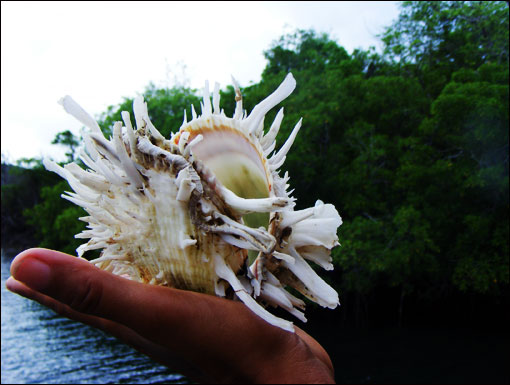
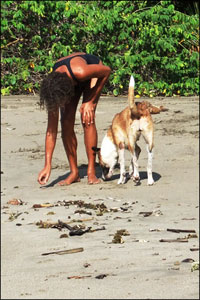
Unfortunately, I can’t hide that I have a Seashell Problem.
Friends get worried when they see me walking the beach. Why keeping the eyes on the ground instead of contemplating waves and horizon as is the custom? “Have you lost something?”
Fishermen watch too. They wonder what profitable business the foreign woman is in. Crab hunting?
Our anchorage neighbours would like to ask what we are bringing back to the boat in that mysterious netbag every morning. Lobsters maybe. (Is that legal?)
All need to know what exactly I am doing on the beach.
“Gathering shells? But what is so exciting about shells, it’s for kids!”
Well… First, let me tell you how I got hooked.
The 3 encounters that got me hooked
1. The camouflaged creature
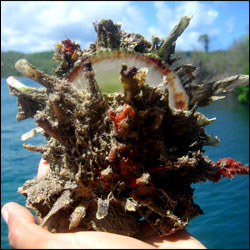 Ugly rock cracked open |
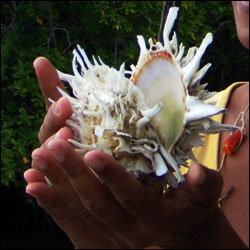 Camouflage removed: the beautiful Digitate Thorny Oyster |
It all started when one day my husband brought back some small rocks from a diving-hunting expedition.
He had seen them …slowly opening, and …quickly closing after he moved. Looked like there was some life inside – therefore something good to EAT!
But once on deck, the poor bivalve rocks refused to open again. They were covered with a forest of algae, sponges and barnacles that was impossible to clean, so we could not simply boil them alive as we usually treat rebellious edible molluscs.
We had to get out the toolbox and use a good amount of swearing to crack them open. (The reward? A ridiculously small piece of meat. But sautéed in garlic butter it made an exquisite appetizer.)
Then, we marvelled at the fine engineering job of the shell’s designer. The ball and socket hinge! The highly-precisioned machined valves that closed so tightly. The glossy comfortable interior…
I soaked one of them in bleach to remove the marine camouflage. The shy “rock” turned out to be a magnificent piece of art, with beautiful spines and leaf-like extensions!
Damned!
I bought a book on Caribbean seashells, started to pluck a few on the beach, put them inside a glass, picked up a few more, and tried to remember their names.
2. The 2nd earring
Some time later, a friend of mine was inspecting rocks, looking for 2 identical sea snails of the same “brand”, in order to make a pair of earrings. They all looked the same but strangely she could not find 2 matching patterns.
Of course! Obvious. Each shell is unique, even within the same specie no 2 shells ON EARTH bear exactly the same pattern…
Unbelievable. I started to keep ALL the seashells that came on my way.
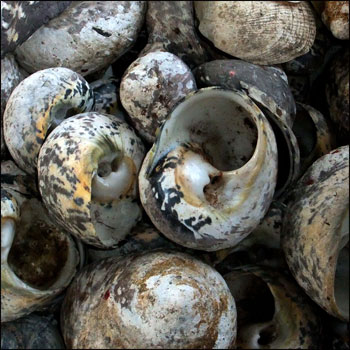 Uninteresting dinner leftover… Uninteresting dinner leftover… |
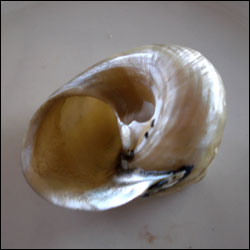 …turned into a pearly beauty …turned into a pearly beauty |
3. The hurricane dinner leftovers
Then, we stormed hurricane Ivan.
The worst part of the hurricane was AFTER the hurricane: specially, there was no food. All was gone: vegetable gardens were gone, fruit trees were gone, supermarkets were looted, and the surviving chickens feared for their life. The seabed was damaged too.
All we could find were big whelks (“West Indian Top Shell, Cittarium pica” said the book), and we started a diet of “Cittarium pica” au gratin. (The “gratin” was imaginary.)
Here in the Caribbean, you see plenty of those common-looking disused shells on the beach and don’t even look at them.
But some worn out parts of the whelks may SHINE. One day I removed the thick black and white external coat from one of them, and guess what I got… An extraordinary mother-of-pearl shell.
This was the last stroke.
 In search of shell treasures (here in the rubble amassed by the surf) In search of shell treasures (here in the rubble amassed by the surf) |
Treasure Hunter Syndrome
Now I suffer from Seashell Disorder.
Sand, mud, rocks, seaweed: I see shells everywhere. My husband got the disease from me. Friends are getting infected.
We can’t resist to the joy of going to the beach EVERYDAY to see what new treasures came with the last tide. We are even afraid we miss the damn tide and perhaps THE unique specimen that would enlighten our day.
Shells are taking over the boat.
I spend hours cleaning them and smiling at them. I keep them around me in dozens of jam or babyfood jars and in baskets.
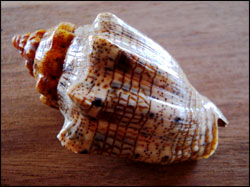 Patterns: can be a combination of dots, stripes, rays, spots, circles, lines, zigzags, bands, or dashes. This one looks like written music (“Music Volute”) Patterns: can be a combination of dots, stripes, rays, spots, circles, lines, zigzags, bands, or dashes. This one looks like written music (“Music Volute”) |
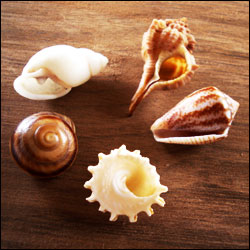 Shapes: Some shells are spiral shaped, other globe-, …ear-, … triangular,- …spindle-shaped, …. oval, bulbus or flat, or look like turrets or cones. Shapes: Some shells are spiral shaped, other globe-, …ear-, … triangular,- …spindle-shaped, …. oval, bulbus or flat, or look like turrets or cones. |
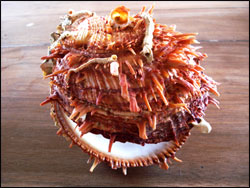 Finishing: Shells can be chalky …or glossy …or finely sculptured with ribs, threads, grooves, ridges …or ornamented with knobs or beads or – like this one – with spines! Finishing: Shells can be chalky …or glossy …or finely sculptured with ribs, threads, grooves, ridges …or ornamented with knobs or beads or – like this one – with spines! |
So why is it so exciting?
Each anchorage is a treasure trove of extraordinary shells waiting to be found.
Each day is a new adventure: waves bring fresh treasures ashore with every tide. But they might take them back too… Shelling is probably more exciting than gold mining, because good spots may appear and vanish overnight!
Each shell is a unique piece of art that makes you happy just by looking at it. It is impossible not to marvel at the hundreds of color, pattern and shape combinations. You simply can’t get tired from the beauty of the seashells.
Well, that’s enough: jump off your boat and go see for yourself.
Searching for seashells on a beautiful beach is one of the best thing you can do to relax your mind. And being on a boat you are in a rather good position to find beautiful beaches…
But beware! Shelling can be addictive. (And it is hard on the back …)
Dead or alive?
Unless you are hunting for seafood, or you are a true seashell collector, there is no reason to take live animals.
There are enough beautiful dead specimen to be found on the beach or the sea bottom. Plus, the process of removing the WHOLE mollusc from its shell can be a disgusting and …smelling business.
Don’t scream if you see one of your “dead” seashells running away: a landcrab simply adopted it as home.
How to make your shells look nice
Some shells don’t look so good, due to encrustations, algae, or wear. Here are some tips to make them look nice:
- You need: patience, time, love
- Soak the shell in bleach (pure or diluted). It removes algae, sponges, and the dark brown skin that covers some shells. Rinse afterwards. Bleach does not harm the colors of the shells.
- Remove encrustations with a small sharp instrument.
- Dissolve the encrustrations that are hard to remove with muriatic acid. Use with gloves and a lot of care, it’s acid! You apply it with a brush or toothbrush and rinse right away or it will dissolve the shell itself…
- Finish by rubbing the shell with mineral or baby oil (thinned with mineral spirits). It makes it shining and looking new. Skip this step if the shell is naturally glossy (or chalky).
Recommended book
by Lesley Sutty – Published by Macmillan Education Ltd.
All I know about Caribbean seashells comes from this book. It has a picture and a basic description for almost each seashell you might encounter in the Caribbean.
About Sylvie
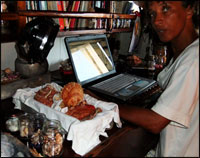 I have been living on the sea since 1990.
I have been living on the sea since 1990.
What I like the most about it is being close to the natural world, that we watch constantly for pleasure (landscapes, skies, fishes, whales and dolphins, birds, shells…), navigation (wind, currents, tides) or safety (weather).
I have never been bored since I set foot on a boat. I design websites – including this one – aboard our boat in the Caribbean.
Sorry for any “franglish” in this post: my first language is French.
Related articles:
Read how other women Take Their Passion Cruising:
- Katharine Lowrie sets sail to protect wildlife
- Elena makes beautiful jewelry from the bone and shell she finds on the beach
- Taking Passions Cruising (Admiral’s Angle column #41)
- See the complete list
What’s your passion? Have you taken it cruising?
Let us know. Email kathy@forcruisers.com or leave a comment below.
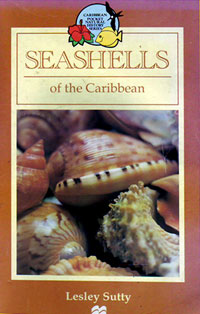

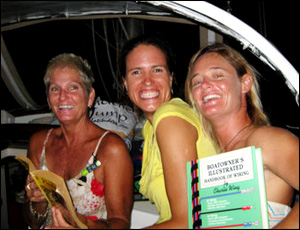
Wonderful!!!! And yes…..that is exactly how it is! People ask me what I do with them….and I say..”nothing!” lol Fill baskets, jars, wine bottles! Kindred spirit! Thanks for sharing.
just returned from my first sailing experience in the BVI. Brought home several west indian top shells and pieces I found on the beaches. How long do I soak them in bleach and how do I remove the outer coating once they have soaked? did a 50-50 bleach solution for 48hrs and nothing really happened. I am so excited to find this blog- went from “scared of water and sailing” to “I cant wait to get back on the water” with this trip. Thanks for the education!
Hello Susan,
The bleach is used to loosen algae. Algae won’t always fall by itself, you might need to scrub the shell to get it off. You can also renew the solution or use pure bleach.
To remove the West Indian top shells external coat, use muriatic acid.
It is a strong acid, so you need to be very careful. Wear work clothes, protect yourself with gloves, glasses, mask and work outdoors. Hold the shell with tongs (that you rinse carefully afterwards).
You dip the shell in acid for 1 to 15 seconds, depending of the size of the shell, then drop it in water to stop the acid action and check the result. Do it again until you are happy with the result and you get a nice mother-of-pearl.
This needs some practice, as if you leave the shell too long in acid the shell itself will dissolve. You can do the “finishing” with a brush dipped in muriatic acid.
Not all “brands” of shells have mother-of-pearl but top shells and star shells do.
All the best
Sylvie
I also love collecting seashells. We usually make 2 trips to the Caribbean each year and I spend most of my time doing just that. I have jars and bottles full of them. Mother nature never ceases to amaze me with her beauty.
I collected many samples of shells and coral. I decided to gift some of the samples to people when I got back home. Some of the fun was looking for specimens for people, kind of like finding the right greeting card.
I kept a modest amount of shells for myself. Certainly I will do it again.